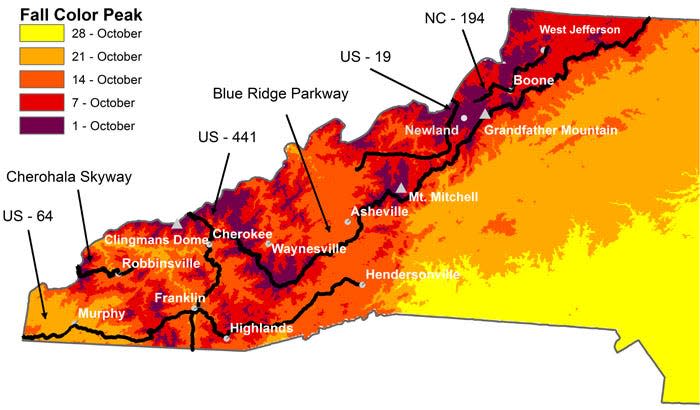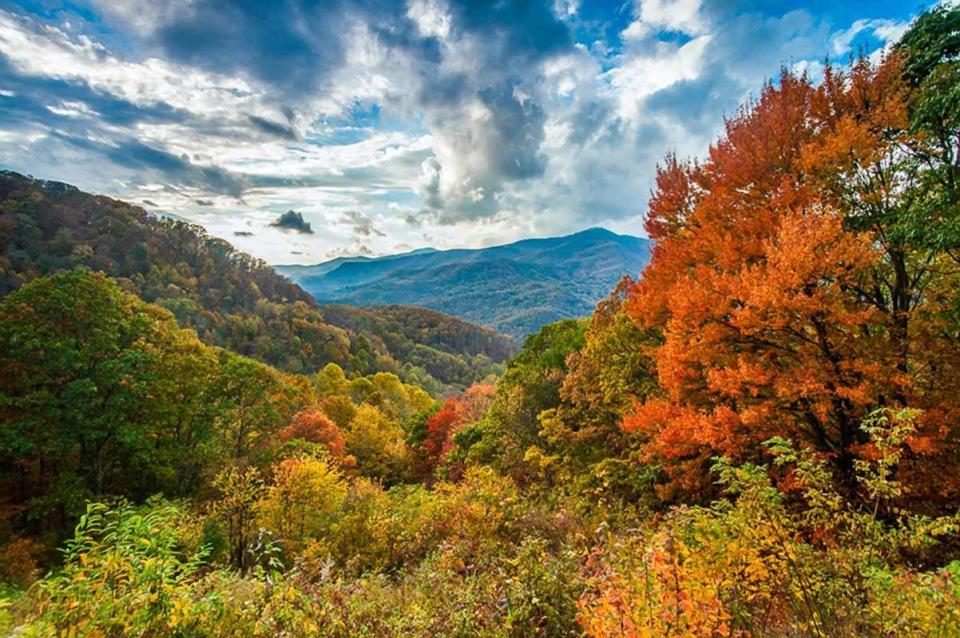Fall foliage tracker: Where are the most brilliant colors in NC peaking right now?
Like most Wilmingtonians, Mary Winters isn't a native.
The recent transplant from New Jersey moved to Southeastern North Carolina for many of the same reasons that have made the Wilmington region one of the fastest-growing metros in the country: affordable cost of living, relative proximity to family in Florida, lower taxes, and mild winters compared to the Northeast.
But Winters admitted she does miss one thing that she used to see all the time at her old house near the Delaware Water Gap in the northern part of the Garden State.
"Seeing the leaves change," she said as she glanced around at the mix of pine and still "green" trees that line many of the paths along New Hanover County's Ogden Park. "It's just not the same here. It's just a little thing, but you notice it."
For folks like Winters, the lack of fall colors is a small price to pay for wearing shorts and T-shirts in mid-October.
But if you feel a need to scratch that fall itch, there are still several weeks to catch the leaves in their full glory.
Thanks to North Carolina's huge elevation differential from Mount Mitchell, at nearly 6,700 feet the highest U.S. elevation east of the Mississippi, to the beaches on the coast, the Tar Heel State has one of the longest fall color seasons in the country.
Leaves change color when trees begin to prepare for winter by slowing down the production of chlorophyll, which creates a green pigment and dominates the other pigments trees produce naturally. As the days get shorter and the nights get longer, trees slow down the production of chlorophyll, allowing the other pigments − yellow, orange, red and purple − to become dominant.
Several factors play a role in where and when leaves start to change color, and they can be easily impacted by weather patterns that they themselves can be influenced by climate change. According to the National Oceanic Atmospheric Administration (NOAA), factors such as temperature, sunlight, precipitation and soil moisture influence fall color arrival, duration and vibrancy.
"A wet growing season followed by a dry autumn filled with sunny days and cool, frostless nights results in the brightest palette of fall colors," the agency states. "Changes in weather can speed up, slow down or change the arrival time of fall’s colorful foliage."

Drought conditions during late summer and early fall can trigger an early "shutdown" of trees as they prepare for winter, causing leaves to fall early without reaching their full color. Freezing temperatures and a hard frost also can lead to poor fall colors, NOAA states.
Temperatures in North Carolina have been relatively normal this year, and NOAA's seasonal temperature outlook for the state is predicting a slight chance of warmer weather heading into the cooler months. But a series of on-and-off dry periods − a move predicted by researchers as climate change impacts weather patterns − have hit large swathes of the Tar Heel State during 2023. According to the U.S. Drought Monitor, much of North Carolina west of Raleigh was facing dry conditions as of mid-October.

What does it all mean?
“If we have warm, sunny days and cool nights with temperatures slightly above freezing, the timing and vibrancy of fall foliage should be similar to past years,” said Robert Bardon, a professor of forestry and environmental resources at N.C. State, in late September.
That means while the height of the fall colors might have already come and gone from the state's highest elevations in the mountains, there's still plenty of time to catch the fall foliage in lower elevations through October before it reaches the coast − albeit in a more subdued form − in early to mid-November.
But there's reading about when the fall colors might be the most magnificent, and then there's seeing it. Check out these sites for more information about the fall colors, when they might hit their peak in certain areas, and how they're looking right now:
North Carolina Visitors Bureau: Information on fall colors and events from the mountains to the sea.
Grandfather Mountain, N.C.: Get a sampling of the popular destination's fall colors along with links to other useful pages.
Fall color in Asheville: Need daily color reports or things to do in the region's cultural and economic hub besides taking lots of pictures of beautiful mountain scenery?
Fall color reports from App State: Get almost daily color reports. Also, don't forget to check out the cool N.C. fall color peak map!
Fall colors in the N.C. Smoky Mountains: Want to know when your favorite valley or scenic drive will hit peak fall foliage?
The Foliage Report: North Carolina isn't the only state for great fall colors. To see what's going on a little further afield, check out the updates on this site.
Fall in South Carolina: New foliage reports posted every Thursday by S.C. State Parks.
Table Rock State Park (S.C.) webcam: See the colors change at this park just south of the state line.

Reporter Gareth McGrath can be reached at GMcGrath@Gannett.com or @GarethMcGrathSN on Twitter. This story was produced with financial support from 1Earth Fund and the Prentice Foundation. The USA TODAY Network maintains full editorial control of the work.
This article originally appeared on Wilmington StarNews: Fall foliage 2023 where to find the most brilliant colors in NC

